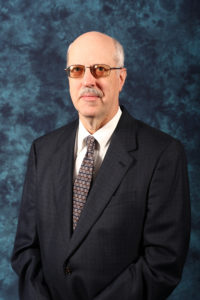Don Helsel
A Thoughtful Manager
By Linda Norlen

Don Helsel worked at the Lighthouse for close to 40 years before he retired. For much of his career he was Director of Manufacturing, overseeing all manufacturing in the building for both the aerospace division and the government.
Later in his Lighthouse career, he served as Director of Recruiting—external recruiting for manufacturing, finance, and human resources. He was especially active as the Spokane satellite facility was ramping up and hiring in 2008. Don estimates he’s hired 100 or more people in his years at the Lighthouse!
The Lighthouse was Don’s first job after graduating from Seattle Pacific University. In his early years, he first worked with the developmentally disabled, then was a production worker in the machine shop, and did setup on manual machines. Not long after that, he was made the lead of an area. After a few years as a lead, Don then became the supervisor of the machine shop.
Legally blind since he was a teenager, Don is one of four siblings who were all stricken with bilateral macular degeneration when they were in their teens. Fortunately, he could still read regular printed documents while he was in school, though today he needs text to be enlarged.
When Don was first working at the Lighthouse, the organization was still thought of more as a “sheltered workshop” than a regular company. With no administrative positions open to the blind, Lighthouse employees were seeking work in the machine shop that they never would have chosen had they been given another option. Their lack of familiarity with mechanical tasks meant they needed extra training. Though some may not have been the most mechanically skilled, Don tried to get the best training for each person and find a position that best fit each of them.
One of the job duties that contributed to Don’s growth was leading shop meetings every month. Having to answer all sorts of questions and explain things in front of a large group of employees gave him confidence. Don also says he learned a great deal from both George Jacobson, the former President and CEO, and Emil Du Pris, head of Finance and HR, who recognized Don’s potential. Don became interested in HR because of the human aspect to it. His goal was always to make a better workplace for everybody and he did a lot of company projects to help bring that about.
Spotting talent was something he had wanted to do. “It’s good for the mission and practical for the organization,” he says. In the early days, sighted people would come to the Lighthouse, use it as a training experience to learn about aerospace, and then go work for Boeing. By spotting talent among the blind, providing adaptive equipment, and training the blind better, The Lighthouse strengthened its workforce and made it more stable—and in doing so, benefitted the population it was meant to benefit.
Reflecting on the many changes at the Lighthouse, Don says there have been changes in the environment, in attitudes, and in the professional development of employees. Having the support of The Boeing Company over the years has also helped improve the wages and benefits that employees receive. Compared to some other organizations affiliated with the National Industries for the Blind (NIB), The Lighthouse is able to provide higher wages than just the federal minimum wage.
The advances in assistive technology for the blind, have been revolutionary, says Don. One example is the improvement of the caliper for precision measurement. The tolerances in the manufacturing work for aerospace are very sensitive. Those with sufficient sight to read a conventional caliper, like Don, could measure those tolerances, but without a new, accessible version of the caliper, blind workers couldn’t check their own work and wouldn’t be able to do quality control on their own. Though the company doesn’t have a formal research and development arm, interested employees developed a caliper that could translate a digital signal to verbal communication, a major step in making high-tech manufacturing viable for the blind.
Looking back over his years as a manager, Don says his ways of approaching how to lead changed over time. After many false starts, he learned to slow down and gather more information before making any big decisions. Don says that in addition to informing yourself, you also need to be able to explain every decision you make, something he always told his supervisors. Often it was most effective to get information to everyone ahead of an issue or problem. He found that addressing an issue early could have a positive impact on how people handled the situation. For example, after 9/11 there was a big turndown in manufacturing at the Lighthouse, a 30% cut to orders in the shop. This meant a comparable percentage of layoffs would be needed. He got out in front of everyone and explained ahead of time, so workers had accurate information to use, rather than just rumors.
Don still keeps in touch with people at the Lighthouse and has lunches with various friends in the organization; there is an ongoing community even beyond people’s working years.